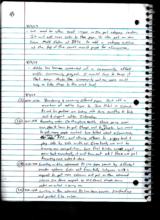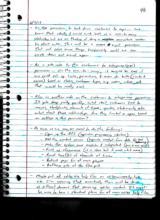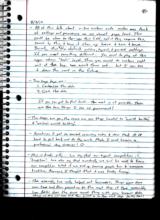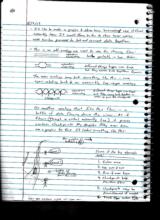|
Basic Assignments
|
Options & Settings
|
Main Time Information
|
||||||||||||||||||||||
|
|
|
|
|
||||||
|
||||||
|
|
|
Notes:
|
|
-Adilas has become somewhat of a community effort and/or community project. I would love to keep it that way. Maybe the community and our users could help us take things to the next level. -On the permission to lock down customer to reps – we know that ideally it would work best as a one-to-many relationship but we are thinking of doing a miniature version to start with. This will be a more rigid permission. That will solve some things temporarily until we can circle down and around again. -As a side note to the customers to salesperson (reps) permission – On the one-to-many, it would be cool if we could set up limits, permission, and even do both (limits and access) based on states, customer types, zip codes, cities, etc. That would be really cool. -Also as another note on the customers to salesperson permission – It gets deep pretty quickly. What about customers tied to invoices, stock/units, elements of time, quotes, statements, etc. What about those relationships? Are they limited or open based on settings in this permission? -As soon as we can, we need to do the following: - Open up the API (application programming interface) - Add the content server (separate content from data for load balancing) - Make the system more modular and independent (tons of mini adilas’) - Finish up eCommerce (it is close but it needs a bit more) - Round two (2) of elements of time - Roll call page for all main players - Reflexive side of the flex grid -Maybe put all adilas.biz help files on adilasuniversity.biz site. I’m assuming that eventually there will be tons of different domains that serve up adilas content. It might be nice to have a standard place for all main adilas help files. -The flex grid is super cool and very flexible – However, we are seeing a need for in-line fields that may be used for parts, invoices, customers, vendors, etc. Almost a custom field level for all of the main 12 system players or groups. The thing that would make it cool is if you could name it, set the data type, set rules and defaults, and then be able to search by these fields according to data types (dates, numeric, decimals, text, and binary). The search ability by data type is super important. -In a nutshell here is what is going on. People are getting creative and recording their data wherever they can right now. They, the companies, then export the data into MS Excel and then use the data to represent different things. It would be nice to help them out. The problem comes in to play as each company is unique and may have different needs. We could add some custom fields but then it makes the whole system a little heavier. This would be a case where we would add static fields in order to increase dynamic usage. I see the need, but I’m not sure we are ready to jump yet in that direction. The ideal would be to allow for unlimited dynamics and allow for those changes to happen and flow within the bounds of the system. This is custom, yet in-line, and fully allowed; that could get kind of tricky. -Another piece to the custom and in-line code is getting each corporation or world by itself. That makes the custom fields weigh less because they only apply to certain worlds and/or corporations. The trick there is updates and changes. If everything is custom – how do you update pages and features. It kind of comes back to in-line custom code. Basically, we know it needs to be custom so, plan for custom right off the bat. -All of this talk about in-line custom code makes me think of settings and permissions on an almost page level. This could be clear to the – use this field, call it this, require this, search by this, and have it show up here and here and here. Basically, this is the default outline, layout, and pre-set settings. If you want something different… you need to play at this upper admin “tech” level. Then you could do custom right out of the box. We aren’t there yet… but I can see it down the road in the future. -Two huge keys are: 1. Centralize the data 2. Catch the data -If you can get to that level – the rest is all possible. Those are the two things I see as paramount! -The deeper we go, the more we see things headed to “world building” and “virtual world building”. -Sometimes I get so excited recording notes and ideas that it is hard to pull back and do the work. Maybe I could become a professional daydreamer! -This is kind of silly – we say that our biggest competition is “tradition”. We also say that eventually we will be used to train our competition. What if we end up training people how to overcome tradition? Anyway, I thought that is was kind of funny. -The assembly line really helped out businesses. Things were done overtime and then passed on to the next step of the assembly line. Adilas does the same exact thing with your business data. Things are done over time and then passed on to the next step. Pretty cool! -I’d like to make a graphic and show how businesses use different assembly lines. It would then be fun to show how adilas uses similar processes to link and connect data together. -This is an old analogy we used to use for showing flow (graphics/sketches for each): operations and accounting - both perfectly in line – static. Operations and accounting – different things happen over time but they come back together – dynamic. The new analogy may look something like this – once again relating back to an assembly line – type analogy: operations and accounting – different things happen over time but they come back together in order to pass the checkpoints. Or another analogy that fits this flow is a bottle of data flowing down the river. As it flows (through a virtual assembly line) it passes certain checkpoints. My daughter even drew me a graphic for this. Some of the key elements are: 1. Enter once 2. Use over and over 3. Run it over time 4. Checkpoints help maintain flow 5. Checkpoints may be permissioned if needed 6. Track the entire life cycle. |





